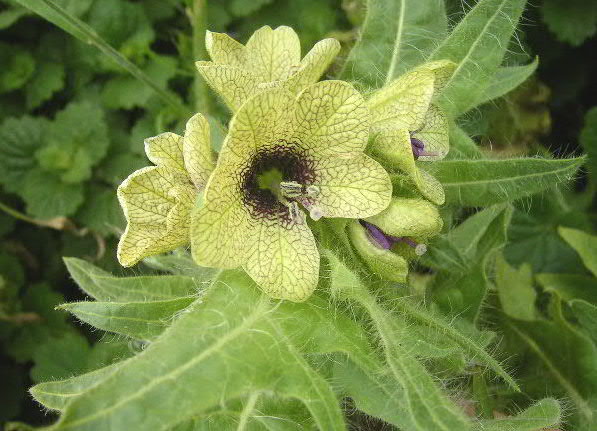 Henbane (Hyoscyamus niger) has a long history as a hallucinogenic plant. It has been used in many cultures around the world. It has been most often used in combination with datura, deadly nightshade and mandrake both as an anesthetic and as a “flying” brew or ointment because it induces the sensation of flying. It is thought to have been used by Viking berserkers after henbane seeds were found in a Viking grave.
Henbane (Hyoscyamus niger) has a long history as a hallucinogenic plant. It has been used in many cultures around the world. It has been most often used in combination with datura, deadly nightshade and mandrake both as an anesthetic and as a “flying” brew or ointment because it induces the sensation of flying. It is thought to have been used by Viking berserkers after henbane seeds were found in a Viking grave.
Great care should be used in handling the plants because all parts of the plant are poisonous. Wearing gloves is recommended. Equal care should taken when preparing it for use medicinally and for magic.
Medicinal uses have included treating rheumatism, toothache, cough and asthma. Interestingly, henbane was used as an ingredient in beer until the Middle Ages when hops replaced the traditional herbal gruit. In modern times, henbane is used as an analgesic, a sedative and a narcotic.
Henbane can be either an annual or a biennial. Both types of plants result from seeds from either annuals or biennials. It is thought that the annual plants result from seeds from the first flowers while the biennial plants result from seeds from flowers produced later in the summer. The annual plants bloom in the first year, while the biennial plants form a rosette of leaves the first year and bloom in the second year. The flowers are yellow with a purple center and purple veins. Bloom time is July and August.
Henbane is native to Europe but has spread around the world. The plants range in height from 2 feet (annuals) to 4 feet (biennials). They require full sun but aren’t picky about soil as long as it is well-drained. The plants have a foul odor so you should plant them well away from your home and outdoor living areas.

Henbane seedpods
It is easy to grow henbane from seed. You can direct sow it into your garden in the fall. Sow them on top of the soil. Do not cover them. they need sunlight to germinate. Not all of the seeds will germinate the first year. They are covered with germination inhibitors that prevent them germinating all at once in case the first year is not favorable for the plants.
If you want to start your seeds indoors, you will need to cold stratify them by refrigerating the seeds for two weeks before planting them. While they are being refrigerated is an ideal time to remove the germination inhibitors by soaking them in water rather than planting them in soil in the refrigerator and changing the water frequently. Soaking the seeds in water leaches the inhibitors off the seeds.
After cold stratifying your seeds, you can plant them in soil. Surface sow the seeds. Do not cover them. They need sunlight to germinate. The resulting seedlings can be transplanted into your garden after your last frost. Give them plenty of space.

